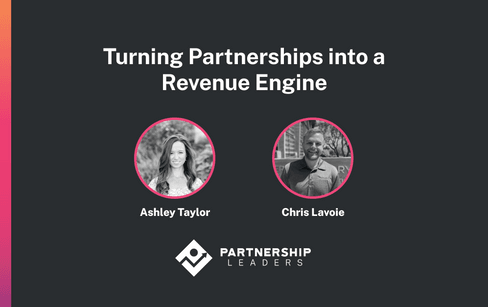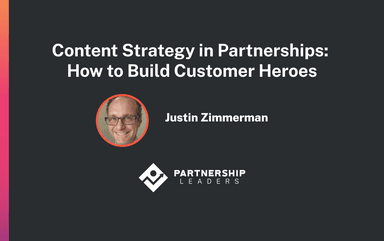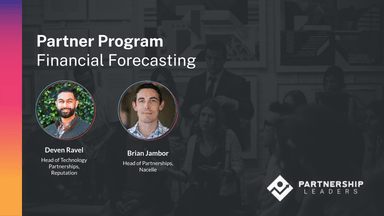Turning Partnerships into a Revenue Engine


Generating revenue and reducing customer acquisition costs are foundational goals of a partner program in most organizations. Unfortunately, turning your partner program into a revenue engine doesn’t happen overnight.
We’re lucky enough to have had Ashley Taylor and Chris Lavoie join us for a panel where they explored proven step-by-step processes to build a path to revenue with partners. Both Ashley and Chris have extensive experience helping partner organizations achieve their goals.
Today, we’ll dig into the top takeaways from the panel that you can implement at your organization.
Forging Organizational Alignment
Before you can begin working toward revenue, you need a top-down culture to support the partnerships effort. It’s essential to understand how your organization thinks about partnerships and their goals. Ultimately, if there’s misalignment on the purpose of partnerships, nothing else matters.
So how do you forge organizational alignment on partnerships? It all starts with personal relationships. While it’s slightly harder to cultivate relationships in our remote-first world, partnerships touch everyone in the organization, and they should understand the potential impact. The CEO and/or founder should be able to clearly articulate their expectations of the partner organization, and the partner leader should be able to clearly advise the C-suite on the support and resources needed to attain these goals.
Once you’ve established those relationships, it’s important to help your team understand how partnerships benefit them (and when done right, partnerships help everyone). Having clear quarterly goals makes it easier to get buy-in from other departments when you need their support on a project.
For example, when you’ve established the forecasted revenue impact from partners, it will be easier to collaborate with the Product Team on building a new partner API.
Getting Started in the Early Stages of a Partner Program
You need to start by quantifying existing opportunities within your organization. Will what already exists help you get to your established goals, or do you need to start from scratch? Establish where you’re at — is your infrastructure set up, like a directory, for instance? Are there key existing customers who are willing to chat with your technology partners about possible integrations or meet with your system integrator partners about business transformation associated with your platform?
Most importantly, you need to be in a position where you can add value to partners. You can have a great product and an expanding brand, but unless you’re able to offer something in return, then you won’t be a great partner.
For early-stage companies, it’s often best to partner with other early-stage companies. In Chris Lavoie’s role, Gorgias is still in an early enough stage where their most successful partnerships are with partners of similar sizes. Gorgias isn’t yet trying to set expectations too far in the future. They’re relying on the past six months to forecast the next six months.
Even if you’re a later-stage company, the investment in ecosystem and marketplaces is still really new. Sometimes there’s value as an early-stage company to get yourself listed on the marketplace of later-stage companies. While it may not directly drive leads, it can still ultimately influence revenue.
Conducting Org Mapping
Something Ashley does early in partnerships is org mapping. While she doesn’t have any rules for when to conduct org mapping, she recommends introducing team members when it seems appropriate. She explained, “I can speak to a roadmap, but our Head of Engineering will speak to our roadmap to another Head of Engineering better than I can. It’s pretty subjective, and there will always be considerations. When you look at your partner plan and roadmap, consider who would benefit from being really excited about different aspects of the plan in each of your organizations. Make that introduction shortly before you plan to bring them into the conversation.”
It’s easier to conduct org mapping when your teams are small. Introducing all relevant team members gets more challenging the larger your organization is. Overall, aim to bring relevant teams in based on the goals. If your efforts are co-marketing heavy, bring the marketing team in early.
Establishing Strong Joint-value Propositions
In the early stages of a partnership, you need to review each side’s goals — they don’t have to be the same, but are they complementary? Set smaller, short-term goals. If you can achieve a smaller set of expectations, you can invest more and more. It’s not feasible to start with everything — start with a subset to ensure you can achieve the deliverables you’re aiming for in a new partnership.
It’s easy for the sales and product teams to get excited about all possibilities. As the partnerships team, we need to start with the unsexy work, as Ashley would call it. Start by partnering to establish your joint value propositions.
If you can’t determine your joint-value proposition, you may not have a valid partnership. If you’re struggling, start with your customer and solve backward from there. Who’s your customer, what do they need, and what gaps do they need to fill?
Just like a lead may have a systematic process of progressing, how can you establish the same rigor with partnerships? There’s an art of the project management aspect, even though it’s not as exciting as other elements of partnerships, and establishing a strong foundation is essential.
In the early stages of a partnership, you also need to be mindful of expectation management. Mutual value doesn’t always mean an equal trade of leads. Even if you can’t deliver leads right away, there’s still something your partner wants from you — understand what they want and set the expectations upfront. You want to avoid surprises later on.
Prioritizing Partnership Opportunities
When allocating resources, start by sizing up the opportunity. Chris has recently started using partner tiers to prioritize time. Gorgias introduced tiers to reward partners who have contributed to their growth. They don’t want to give away too many resources to partners who haven’t earned it yet and instead incentivize them for getting there. Right now, Gorgias bases their tiers on revenue, and while it’s not a perfect model yet, it’s something that’s evolving.
The partner with the largest total addressable market isn’t always the best partner for you. In fact, if they’re a larger organization, they likely have other commitments. Until you can confirm they can support what you’re looking for, don’t over-prioritize the opportunity.
In terms of prioritization, Ashley lives and dies by Crossbeam in understanding where there’s a strong customer overlap. When it’s a new partnership, you don’t have historical data to fall back on. She considers, were we able to develop a joint value proposition? Do our customers overlap? Does our price point align?
Developing Powerful Co-marketing Campaigns
While you won’t always deliver a surplus of leads to each new partner, you can consider how you can play to your strengths. For example, if you have a fantastic content team look at the content roadmap and how partners can fit in.
Don’t try to reinvent the wheel in your efforts. Focus on what your team is already excelling at. If your team has a webinar, could you host partners as speakers? Maybe your partner has a well-oiled blog. Can you identify what kind of content they care about and ways you can make their content stronger? Play to each of your strengths.
Access Powerful Insights for Driving Revenue Through Your Partner Program
It’s important to do the “unsexy” work. Driving revenue with partnerships doesn’t happen overnight — you have to first build a strong foundation. You should also avoid overcommitting. Instead of throwing everything you can at partners, just test a few things. Find a few partners you can rely on, then go after more.
If you’re early in the process, be sure to document your efforts. Even if you use a Google Doc, take notes of your lessons learned, and you’ll always have great tips to draw on.
Thanks again to Ashley Taylor and Chris Lavoie for sharing their insights on driving revenue. You can connect with Ashley and Chris on LinkedIn and in the Partnership Leaders community. If you missed the panel and want to watch the entire event, you can access it here by submitting the form.
Partnership Leaders connects professionals from modern technology companies looking to advance their careers, expand their partner programs, and grow their organizations. Whether you’re looking to land a new role in partnerships, excel in your current role, or grow your team, Partnership Leaders has resources for it all. Apply now to network with over 700 partnerships professionals.

